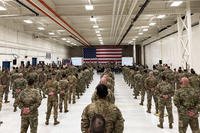Just this month alone, the Army has screened more than a million Soldiers -- pre- and post-deployment -- to ensure they are healthy both physically and mentally, before deployment and after they return home to their families.
The Deployment Health Assessment Program, or DHAP, screenings are part of an ongoing Army effort to assess the health of Soldiers involved in deployments. Such screenings happen before deployment, and twice after returning home.
The DHAP is a key element in the Army's Ready and Resilient Campaign, an effort to integrate and synchronize multiple efforts and programs to improve the readiness and resilience of Soldiers and their families.
The Army began screening active duty, Army Reserve and Army National Guard Soldiers though DHAP in August 2006.
The DHAP includes three individual assessments, including the pre-deployment health assessment, which is taken before a Soldier deploys; the post-deployment health assessment, which is taken within 30 days of returning home; and the post-deployment health reassessment, which is taken within six months of returning home.
All three assessments involve resilience training, the completion of an electronic form that asks various questions about a Soldier's health, and a one-on-one confidential meeting with a healthcare provider.
While the pre-deployment health assessment questionnaire is short -- asking a limited number of questions about current medical health -- the follow-on questioners are more detailed, delving into both physical and mental health, and touching on the specific kinds of events a Soldier might have experienced while deployed.
The DHAP is intended to evaluate both the physical and mental health of a Soldier before and after deployment.
"As Soldiers we all have challenges downrange," said Maj. Christine Ludwig, DHAP program manager. "This program examines what we as Soldiers go through on a personal level. Soldiers deploy to combat zones, support humanitarian missions, and respond to natural disasters. This program aims to identify conditions and symptoms as early as possible in every type of deployment."
The DHAP plays a unique role across the Army, both as a tool used to identify physical and behavioral health concerns, and also as a conduit to various forms of treatments, access to medical services and other health programs, all with the goal of taking care of Soldiers.
"We have seen that for every Soldier in the deployment cycle who gets help, there is a commander reinforcing the message and raising awareness," said Maj. Tracie Willie, who works within the Army National Guard's surgeon general's office.
Important challenges to overcome are the stigmas associated with seeking help during the deployment process.
"Soldiers have a negative perception of the process for reporting medical issues," said Capt. Quana Wright, DHAP manager for the Army Reserve. "Overall there is a reluctance to seek help, which then becomes a barrier for reporting, diagnosing and seeking medical care. Some Soldiers believe getting help will hinder career advancement and certain kinds of diagnosis or treatment will be reported as the Soldier not being fit for duty."
Wright said the Army and the DHAP program have worked hard to dispel that misconception.
"As leaders and Soldiers we need to be the front line to dispel these types of myths and stigmas," Wright said. "We are currently working with Army Reserve Command to dispel these stigmas and communicate the medical process for care following deployment health assessments -- it is this kind of open dialogue that pays off in great dividends for Soldiers."
Ludwig urges all Soldiers to actively participate in the deployment assessment process.
"DHAP brings the medical care system to the Soldier," she said. "It allows them to tap directly into the system to get the care they need, when they need it the most."
The Deployment Health Assessments are required for all deployments outside the continental United States that last longer than 30 days to locations that are not supported by a fixed U.S. military treatment facility. It is a commander's decision to weigh environmental risks and health threats to determine the need for Deployment Health Assessments for all deployments 30 days or less.


















